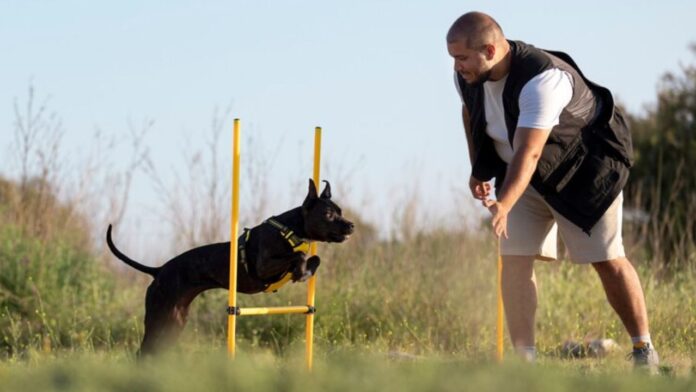Is your dog not able to pay attention outside?
Does it also get reactive or overexcited towards other dogs?
If yes, then it is essential to address these issues, as they can have negative consequences for the dog and its human companionship.
To ensure that the bond between the dog and human is as tight as a rope knot, it is worth considering to look out for dog behaviour classes.
If you are wondering about these classes, why you should consider them, and how to choose the right one, we will help you with that.
Table of Contents
What are Dog Behaviour Classes?
These classes are structured training programs aimed at improving your dog’s behaviour and obedience skills.
They typically cover a range of topics, including basic obedience commands, leash manners, socialization with other dogs and people, and addressing specific behavioural issues such as aggression, anxiety, or excessive barking.
Classes may be conducted in group settings or through private one-on-one sessions, depending on your dog’s needs and your preferences.
Why Consider These Classes?
Structured Learning Environment:
These classes provide a structured and organized setting where both you and your dog can effectively learn.
With experienced trainers leading the sessions, you’ll receive guidance on proper training techniques and strategies tailored to your dog’s needs.
This structured approach ensures a focused learning experience, leading to better results in obedience and behaviour modification.
Socialization Opportunities:
Group classes offer invaluable opportunities for your dog to socialize with other dogs and people in a controlled environment.
Through positive interactions during training sessions, dogs learn to become more comfortable and confident around unfamiliar situations, reducing fear and anxiety.
Socialization also helps prevent behavioural issues stemming from isolation or lack of exposure to different environments, ultimately leading to a well-adjusted and friendly companion.
Addressing Behavioral Issues:
These classes are designed to tackle specific behavioural issues that your dog may be experiencing, such as aggression, fearfulness, or separation anxiety.
Trainers work closely with you to understand the root causes of these behaviours and develop personalized training plans to address them effectively.
By targeting problem behaviours directly, you can help your dog overcome challenges and lead a happier, more balanced life.
Building Trust and Bond:
Training with your dog fosters a strong bond and mutual trust between you and your furry companion. Through positive reinforcement techniques, you’ll communicate effectively with your dog, building a foundation of trust and understanding.
This bond enhances your relationship, leading to better cooperation and companionship both at home and in various social settings.
Promoting Positive Reinforcement:
Many behaviour classes emphasize positive reinforcement techniques, which have been proven to be highly effective in training. By rewarding desired behaviours with treats, praise, or toys, dogs learn to associate obedience with positive experiences.
This approach not only yields better results but also fosters a positive and loving relationship between you and your dog, ensuring a harmonious training experience.
How To Choose the Right Behaviour Class for Your Dog
Assess Your Dog’s Needs:
Begin by identifying your dog’s specific behavioural issues or training goals. Whether it’s basic obedience, addressing aggression, or overcoming anxiety, understanding your dog’s needs is crucial in selecting the right classes.
Research Training Methods:
Prioritize classes that utilize positive reinforcement techniques, fostering a supportive and encouraging learning environment. Avoid classes that rely on punitive measures, as these can be detrimental to your dog’s well-being.
Check Trainer Qualifications:
Ensure the dog trainers leading the classes are experienced, certified professionals with a strong understanding of dog behaviour and training methods.
Visit the Facility:
Take a tour of the training facility to assess its cleanliness, safety protocols, and overall atmosphere.
Observe a Class:
Witnessing a session firsthand allows you to evaluate the effectiveness of the trainers’ methods and the dynamics between dogs and instructors.
Inquire About Class Structure:
Ask about class size, curriculum, and instructor-to-dog ratio to ensure personalized attention and tailored learning experiences.
Consider Your Schedule:
Choose classes that fit your availability and commit to consistent training sessions for optimal results.
Seek Recommendations:
Consult friends, family, or veterinarians for trusted referrals based on their experiences with dog behaviour classes.
Check Reviews and Testimonials:
Research online feedback to gauge client satisfaction and the effectiveness of the classes.
Evaluate Cost and Value:
Consider the cost of the classes in relation to the quality of instruction, trainer qualifications, and potential benefits for your dog’s behaviour and overall well-being.
Conclusion
Addressing your dog’s behavioural issues through structured dog behaviour classes not only strengthens the bond between you and your furry friend but also promotes a harmonious and fulfilling companionship. By considering your dog’s needs, researching training methods, and selecting the right classes, you can embark on a journey towards improved behaviour and a happier, healthier relationship with your beloved pet.
